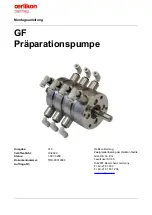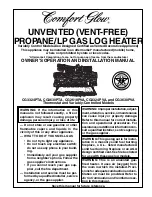
LP-644 Rev. 8.10.17
25
Improper seating of vent pipe gaskets can cause eventual gasket
failure and exhaust gas leakage. Ensure the exhaust vent pipe is
properly beveled and seated before insertion into the flue adapter.
Failure to do so could result in property damage, severe personal
injury, or death.
Due to the extreme flammability of most glues, cements, solvents,
and primers used to join plastic exhaust vent and intake pipes,
explosive solvent vapors must be cleared from all vent piping
before start-up. Avoid using excess cement or primer, as this may
pool in the vent pipes. Vent assemblies should be allowed to
cure for a period of at least 8 hours before powering a connected
appliance. Failure to follow these instructions will result in
substantial property damage, severe personal injury, or death. It is
the installers’ responsibility to understand the hazards associated
with explosive solvents and take the necessary precautions to
avoid these risks.
CPVC, Polypropylene, or Stainless Steel pipe material MUST be
used for the first 3 feet of the vent run if the exhaust vent passes
through an enclosed space greater than 6”, such as a wall. The
balance of the vent run can be installed with standard Schedule
40 PVC pipe. Failure to comply with this warning could result in
property damage, severe personal injury, or death.
Exhaust vent adaptors are not designed as load-bearing devices,
and must not be used to support exhaust vent piping. All vent
pipes must be properly connected, supported, and the exhaust
vent must be pitched a minimum of 1/4” per foot back to the heater
to allow drainage of condensate. Failure to properly support vent
piping and follow the information in this statement could result in
product damage, severe personal injury, or death.
B. Approved Materials for Exhaust Vent and Intake Pipe
•
The exhaust and intake components installed with this heater must be used for near heater piping BEFORE transitioning to the
approved materials listed above. DO NOT REMOVE these installed components. Doing so WILL VOID heater warranty.
•
PVC / CPVC pipe and fittings of the same diameter are considered interchangeable.
•
Use of cellular core pipe PVC (ASTM F891), cellular core CPVC, or Radel® (polyphenysulfone) in nonmetallic venting systems is
prohibited.
•
DO NOT connect PVC/CPVC to Polypropylene without an approved vent connector.
•
Any transition to Polypropylene MUST be done in the vertical within five (5) feet of the appliance.
•
When installing AL29-4C vent piping, install a PVC-to-stainless adapter at the heater vent connection, and at the termination when
using a PVC termination kit. DO NOT mix AL29-4C piping from different manufacturers unless using adapters specifically designed
for the purpose by the manufacturer.
•
Covering non-metallic vent pipe and fittings with thermal insulation is prohibited.
•
A double wall vent may be used when using stainless steel vent material in a freezing climate.
•
*PVC-DWV may be used for air intake applications ONLY.
•
Contact the venting material manufacturer if there is any question about the applicability of the proposed venting material.
Failure to follow these directions will result in substantial property damage, severe personal injury, or death.
Table 16 - Approved Materials for Exhaust Vent and Intake Pipe
Item
Material
Standards for Installation In:
United States
Canada
Exhaust Vent or Intake Pipe
and Fittings
PVC Schedule 40/80
ANSI / ASTM D1785
PVC, CPVC, and PP Venting Must be
ULC-S636 Certified. IPEX is an ap-
proved manufacturer in Canada.
PVC-DWV*
ANSI / ASTM D2665
CPVC Schedule 40/80
ANSI / ASTM F441
Polypropylene
UL-1738 or ULC-S636
Stainless Steel AL29-4C
Certified for Category IV and Direct Vent Appliance Venting
Pipe Cement
PVC
ANSI / ASTM D2564
IPEX System 636 Cements and
Primers
CPVC
ANSI / ASTM F493
Pipe Primer
PVC / CPVC
ASTM F656
Содержание CGH-199*
Страница 40: ...LP 644 Rev 8 10 17 40 Figure 38 Electrical Wiring Diagram...
Страница 41: ...LP 644 Rev 8 10 17 41 Figure 39 Ladder Diagram...
Страница 69: ...LP 644 Rev 8 10 17 69 Notes...
















































